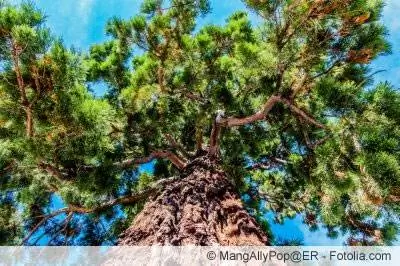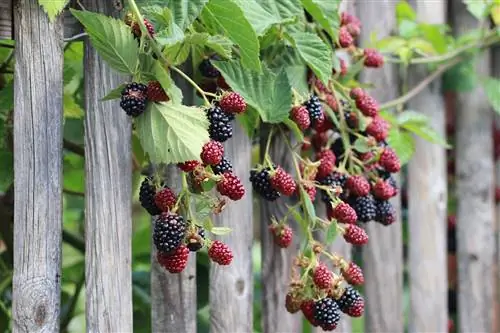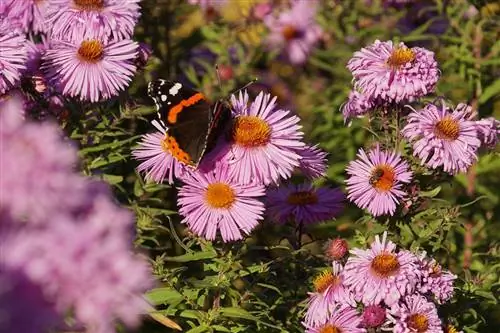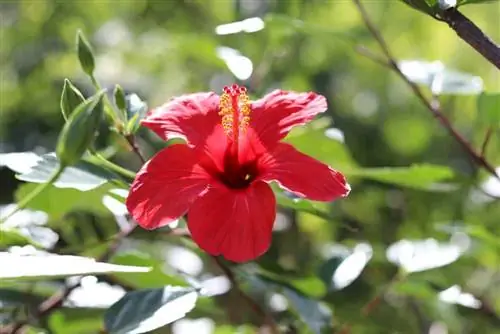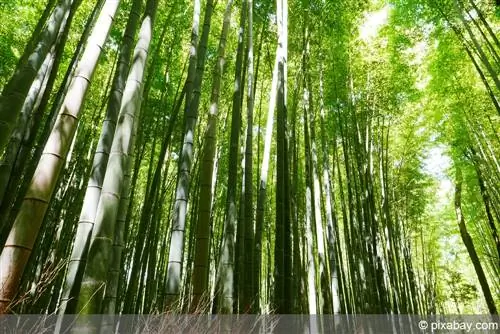- Author admin [email protected].
- Public 2023-12-17 03:39.
- Last modified 2025-01-24 12:45.
It is one of the most impressive, largest and oldest trees ever and can still be admired in many different forms in Germany today. We are talking about the giant sequoia tree, botanically Sequoiadendron giganteum. The impressive coniferous tree is perfect for the local climatic conditions and can quickly become an eye-catcher and a pleasant source of shade in the garden. However, it requires a lot of space. Apart from that, the sequoia tree is an extremely easy-care and robust plant that can be cultivated with little effort even by gardeners who do not yet have much experience.
Short profile
- Botanical name: Sequoiadendron giganteum
- other names: giant sequoia, giant sequoia, mountain sequoia, wellingtonie
- belongs to the cypress family (Cupressaceae)
- Growth height: 50 to 95 meters
- Growth rate: 60 to 90 cm per year
- straight trunk, very thick with age
- Foliage: scale-shaped, blue-green needles
- Fruits: small, rounded cones
- Root: usually not deeper than 1 meter, but very wide
- largest known tree species
- Age: up to over 3500 years
- evergreen
Species and occurrence
Natural occurrences of Sequoiadendron giganteum are now only found on the western slopes of the Sierra Nevada at altitudes between 1300 and 2000 meters. In California's nature reserves, the stately tree grows in moist locations with high amounts of rainfall. Giant sequoias usually form smaller groves amid ponderosa pines (Pinus ponderosa), sugar pines (Pinus lambertiana), grand firs (Abies magnifica) and Colorado firs (Abies concolor). The sequoia tree used to be widespread in Asia and Europe. Despite its size, the sequoia tree was only discovered in the middle of the 19th century and reintroduced to Europe by British scientists. Special breeding forms are:
- Sequoiadendron giganteum 'Aureum': cultivated form from Ireland, grows slower and is only 20 meters high, dull yellow shoot tips
- Sequoiadendron giganteum 'Glaucum': bluish scale needles, grows somewhat weaker and less wide
- Sequoiadendron giganteum 'Pendulum': rare form from France, narrow columnar growth, height up to 28 meters
Care instructions
In the following you will find out everything about the ideal growing conditions for the sequoia tree in the garden. Yes, keeping them in the garden is possible. Read more here
Location
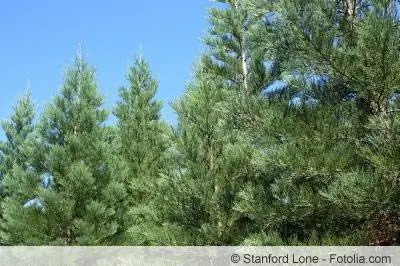
The location for a sequoia tree should be chosen carefully. Ultimately, over the course of its life, the tree reaches impressive heights and thus gigantic root dimensions. If planted too close to the house or a fence, it can eventually cause problems after years. Sequoiadendron giganteum deserves a solitary position in the garden, preferably in a sunny to partially shaded location. Apart from a good water storage capacity, it does not place any special demands on the soil.
- Individual position
- sufficient distance from buildings and property boundaries
- Light requirements: sunny to partially shaded
- Young plants protected from the wind
- humous, moist soil
Tip:
The mountain sequoia tree reaches heights of up to 10 meters after just 10 years.
Plants
Young specimens of the sequoia tree are preferably planted somewhat sheltered so that they are not exposed to direct wind during the cold season. In nature, too, the giant sequoia is initially protected by neighboring pines and firs, which it only towers over as it grows older. Since young trees are still somewhat sensitive, the tree should only be planted outdoors when it is over one meter tall.
- Time: Spring or Autumn
- choose cloudy or rainy day
- Planting distance from buildings: 15 to 20 meters
- possibly observe local limitation guidelines
- Deeply loosen the soil
- Planting hole: three times the size of the root ball
- Planting depth: flush with ball level
- fill in humus-rich soil and tamp it down
- Draw a trench around the planting hole at a distance of about 50 to 60 cm
- Depth: 5 to 10 cm
- water regularly in the first few months
- Avoid waterlogging and dryness
Tip:
In the North American region of origin, the ground cover hazelroot can often be found as a companion plant to the sequoia tree. It is therefore advisable to include a few hazel root plants (Asarum caudatum) when planting the tree. The underplanting offers good root protection in summer and winter (against water evaporation and cold).
Pouring
A sequoia tree is very sensitive to drought. While the conifer is otherwise very adaptable, there is nothing worse for it than insufficient amounts of water in the root area. A larger Wellingtonia can completely dry out soggy soil in just one day. However, the tree does not suffer from persistent waterlogging. However, it usually survives short-term root wetness unscathed. If the watering behavior is incorrect, the coniferous tree becomes susceptible to diseases such as fungal infections. Regular watering is therefore crucial for good growth and prosperity. A ring trench around the root area that is approximately five centimeters deep has proven to be helpful for irrigation in the initial period after planting outdoors. Older trees also need to be watered regularly during drought.
Fertilize
If the giant sequoia tree is about one meter tall and is planted in its final location in the garden, you must not forget to carefully supply the coniferous tree with nutrients. This increases root production the following year and the plant grows well. A long-term fertilizer such as compost or horn shavings, which only releases its nutrients slowly, should be used. Mineral fertilizers quickly burn the sensitive roots. In the following years, some mature compost or slow-release fertilizer is mixed into the soil in spring.
Cutting
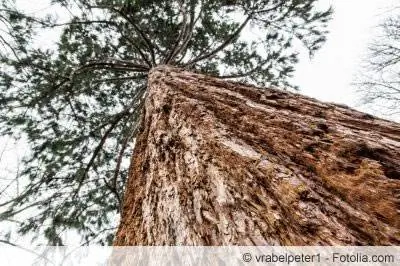
Sequoias, like other conifers, do not require any pruning. Only sick or dried shoots should be removed regularly.
Propagation
Although the mountain sequoia can be propagated through cuttings, these are very susceptible. Hobby gardeners rarely manage to cultivate full-grown trees from them. A simpler but time-consuming method is propagation from seeds. These can be purchased from specialist retailers or can be harvested from existing trees. The sequoia tree only becomes “manable” when it is around 10 to 15 years old. The male flower is at the end of short shoots. The tree produces amazingly small female cones. These are only 5 to 8 cm long and up to 5 cm thick. In the first year the unripe green cones stand upright at the ends of the branches, in the second year the mature cones hang down. The cones contain flat, yellowish seeds about 5 millimeters long.
Stratification
Nature has equipped the seeds of the sequoia tree with a germination inhibitor so that they do not accidentally germinate in the fall and thus suffer major losses due to frostbite in winter.
- place purchased seeds in the refrigerator (in a bag)
- first place the harvested seeds in a slightly moistened coffee filter
- pack this in a freezer bag and put it in the fridge
- Duration: four weeks
- Temperature: about 5 degrees
Tip:
Many gardeners have also had good experiences with the germination rate when they put their seeds in the freezer for two weeks.
Sowing
So that the seeds have good moisture conditions, it makes sense to soak them in room temperature water for one to two days before sowing them.
- place swollen seeds on moist, high-quality potting soil
- Substrate: low in nutrients, high mineral content (very important)
- Distance: at least 3 cm
- just press
- do not cover with soil (light germinator)
- Seeds must be in intensive contact with the soil
- never let it dry out
- Germination rate is low, so it is better to sow several seeds
- Use a mini greenhouse or put a plastic bag over it
- place brightly (without direct sun)
- Temperature: room temperature
- ventilate regularly
- Germination time: 2 to 5 weeks
After germination, the cover is removed and the young plants are placed in a shady place to prevent drying out. From a size of around 3 to 5 centimeters, they are transplanted into individual pots. A humus-rich soil with good water storage capacity is suitable as a substrate. The most important thing is regular watering. The sequoia tree should not be placed directly above the heater due to the dry air conditions. If branches slowly begin to grow, the young plant needs a little more light. However, direct sun should still be avoided. Once the plants are used to the sun, they can go outside during the day if the temperatures are moderate.
Care for young plants
As an established tree, the sequoia tree can survive almost all weather conditions and even harsh winters without any problems. However, this does not apply to young plants. Very small sequoias should therefore not be cultivated directly outdoors, but up to a size of around 15 cm in a planter with a diameter of around 12 to 15 cm. From a height of 15 centimeters it makes sense to plant the sequoia in a very large pot. This is the only way to ensure that the roots develop well and do not dry out. The growth power of the roots of the giant sequoia tree should not be underestimated. That's why the plant needs very large planters right from the start. If the tree is grown in a small pot for too long, spiral roots will form due to lack of space. The strong core root is suppressed. These plants later find it very difficult to grow well outdoors. From a height of one meter, the sequoia can then be planted in its final place in the garden.
Interesting facts
On the orders of King Wilhelm I, the Stuttgart Forestry Directorate was supposed to buy one pound of seeds from the largest tree in the world in 1864. Since no one knew how small the giant's seeds were, the forestry department received around 100,000 individual seeds, which have produced almost 8,000 plants. The young trees were then distributed throughout Baden-Württemberg. Many of them can be admired today in the Wilhelma, which was then run as a botanical garden.
Wintering
In wine-growing regions, even young sequoia trees are hardy without any problems. In all other areas, frost protection is recommended during youth or even cultivation in a bucket for young plants. As with many other tree species, Sequoiadendron giganteum's winter hardiness increases significantly with age. Well-grown specimens can easily survive temperatures of -30 degrees in winter. However, it should always be borne in mind that the roots of the mountain sequoia are somewhat sensitive because they are so close to the surface of the earth. For this reason, in snow-free areas it must be protected from freezing with a thick layer of brushwood or mulch.
- Overwinter young plants in the bucket in the cold house
- Don't put it in a warm apartment!
- Unheated greenhouses or garages with windows are suitable
- Trees from 1 meter high can overwinter when planted out
- Winter protection necessary
- Cover the roots with brushwood, leaves or mulch
- protect from icy winds with Windshot (tarpaulin)
- water in winter if it is dry
The young sequoia trees can also be buried in the garden soil in a protected place, including the pot. The plant has a hard time overwintering warmly. It should be kept cold but protected from cold winds. If there is no protective layer of snow, the ground must be watered occasionally to avoid dry damage.
Color changes in winter
Young giant sequoias typically go through different shades of color during the winter until spring. The stronger the color change, the more susceptible the plant is to the reaction. Seedlings under one year old are most commonly affected. This color change to wine red, rusty brown or even violet is not observed every year; it usually occurs after a sudden cold snap or after a warm period that is untypical for winter. Sufficient amounts of water in the soil have been proven to reduce the susceptibility of conifers during this time. Seedlings and young plants covered with snow do not show this phenomenon. The discoloration itself does not harm the plants because it is simply a pigment that was already present. This condition disappears suddenly if there is sufficient irrigation and the temperatures remain warm again for a longer period in spring.
Diseases and pests
As a rule, fungi and insect pests do not pose a serious threat to the mountain sequoia tree. Young plants are still somewhat sensitive to wind in cool temperatures, otherwise there is hardly anything that can actually harm the tree. Woodpeckers and squirrels like to nest in old trees. However, the nesting holes do not pose a threat to the he alth of the tree. The only thing that can kill a sequoia tree in summer and winter is a dry root ball. That's why the soil should be constantly checked for moisture, even in winter. The main cause of death in redwoods is drought.
Conclusion
The giant sequoia tree can be easily cultivated in all areas with a temperate climate. Sequoiadendrum giganteum is very adaptable. The limiting factor for the he althy growth of the tree is the availability of water in the root zone. In dry times, the tree must therefore be watered consistently - even in winter.

